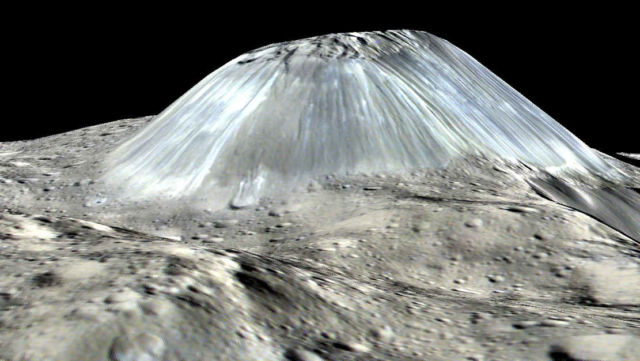NASA’s Dawn mission reveals that dwarf planet Ceres hosts an unexpectedly young cryovolcano that formed with the past billion years.
A lonely 3-mile-high (5-kilometer-high) mountain on Ceres is likely volcanic in origin.
The dwarf planet may have a weak, temporary atmosphere. These are just two of many new insights about Ceres from NASA’s Dawn mission published this week in six papers in the journal Science.
Above, Ceres’ lonely mountain, Ahuna Mons, is seen in this simulated perspective view. The elevation has been exaggerated by a factor of two. The view was made using enhanced-color images from NASA’s Dawn mission. Credits: NASA/JPL-Caltech/UCLA/MPS/DLR/IDA/PSI
“Dawn has revealed that Ceres is a diverse world that clearly had geological activity in its recent past,” said Chris Russell, principal investigator of the Dawn mission, based at the University of California, Los Angeles.
A surprising finding emerged in the paper led by Russell: Dawn may have detected a weak, temporary atmosphere. Dawn’s gamma ray and neutron (GRaND) detector observed evidence that Ceres had accelerated electrons from the solar wind to very high energies over a period of about six days. In theory, the interaction between the solar wind’s energetic particles and atmospheric molecules could explain the GRaND observations.
A temporary atmosphere would be consistent with the water vapor the Herschel Space Observatory detected at Ceres in 2012-2013. The electrons that GRaND detected could have been produced by the solar wind hitting the water molecules that Herschel observed, but scientists are also looking into alternative explanations.
“We’re very excited to follow up on this and the other discoveries about this fascinating world,” Russell said.
source NASA






Leave A Comment